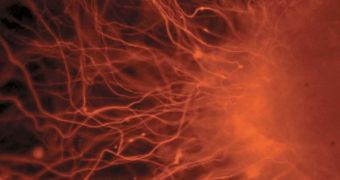Stem cells hold great promise in the field of medicine, as they could potentially be used to treat severe wounds, or even to create replacement organs for patients. But there are currently some issues associated with using these cell lines. Most of the problems have something to do with their growth, differentiation and proliferation processes, which take place too fast at this point. Now, experts at the University of Hong Kong, in China, and the Massachusetts Institute of Technology (MIT), in the US, may have discovered a way of keeping stem cells “forever young.”
In a research paper the group published in the latest issue of the scientific journal Cell Transplantation, it is shown that the cells can be kept in their original, young state for longer if the three aforementioned processes are slowed down significantly. The find could be of great importance, the research team believes. “The successful storage and implantation of stem cells poses significant challenges for tissue engineering in the nervous system, challenges in addition to those inherent to neural regeneration,” the corresponding author of the new paper, Dr. Rutlege Ellis-Behnke, explains. The expert is based at the University of Hong Kong Li Ka Shing Faculty of Medicine.
“There is a need for creating an environment that can regulate cell activity by delaying cell proliferation, proliferation and maturation. Nanoscaffolds can play a central role in organ regeneration as they act as templates and guides for cell proliferation, differentiation and tissue growth. It is also important to protect these fragile cells from the harsh environment in which they are transplanted,” the scientist says. With the modern advancements in nanotechnology, Ellis-Behnke continues, “self-assembling nanofiber scaffolds” (SAPNS) could be the next logical step in this line of research.
“Fine control of the nanodomain will allow for increased targeting of cell placement and therapeutic delivery amplified by cell encapsulation and implantation,” the expert adds. The newly developed SAPNS provide crucial help and support for cell adhesion and migration, and also help transplanted cells have a higher survival rate. The growth and differentiation of the stem cells is also slowed down, which gives the cells themselves more time to adjust to their new environment. “That delay is very important when the immune system tries attacking cells when they are placed in vivo,” Ellis-Behnke says.
“Implanted stem cells are adversely susceptible to their new environment and quickly get old, but this study suggests a solution to conquer this problem. The self-assembling nanofiber scaffold (SAPNS) provides a niche for the encapsulated stem cells by slowing down their growth, differentiation and proliferation, as well as potentially minimizing the immune response, thus enhancing the survival rate of the implanted stem cells,” China University Medical Hospital Professor of Neurosurgery Shinn-Zong Lin adds.

 14 DAY TRIAL //
14 DAY TRIAL //